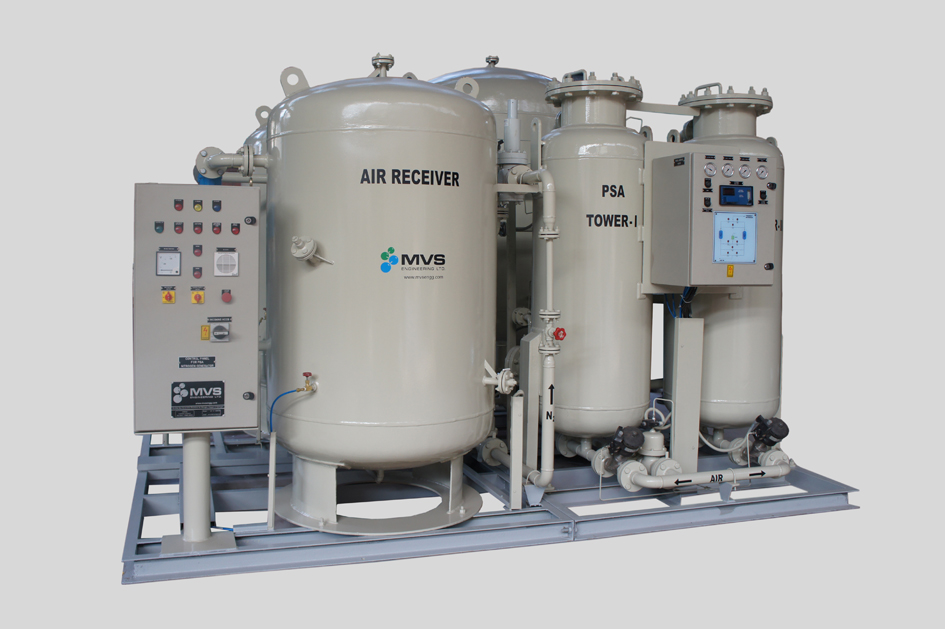Ship’s Nitrogen Gas Generator
Nitrogen gas generators are used to produce clean and dry nitrogen of higher purity for inerting, purging and cargo padding.
Mainly there are two types of nitrogen generators are widely used on board:
- One type uses hollow fiber membrane technology and
- Other one is based on the Pressure Swing Absorption (PSA) process.
Nitrogen may also be supplied from ashore in nitrogen cylinders and stored on board, but nitrogen generators are most convenient way for inerting, purging and cargo padding.
Requirement of nitrogen used as inert gas on chemical tankers:
On tankers nitrogen is not used for fighting fire but for cargo quality control.
Some cargoes are very much oxygen sensitive to react with and may turn to out of specification. Some cargo may also react with carbon di oxide in the flue gas. Other cargoes are highly sensitive to moisture and may liable to discoloration. The cargoes require inert gas of extreme purity to exclude oxygen from the tanks.
Oil fired flue gas contains less oxygen but at the same time it contains soots and carbon di oxide which may react with cargoes. For these reasons oil fired flue gas systems are rarely used on chemical carriers.
Inerting:
The introduction of inert gas into a tank with the object of attaining the inert condition.
Purging:
The introduction of inert gas into a tank already in the inert condition with the object of:
(1) further reducing the existing oxygen content; and/or
(2) reducing the existing hydrocarbon gas content to a level
Topping up: The introduction of inert gas into a tank which is already in the inert condition with the object of raising the tank pressure to prevent any ingress of air.
Nitrogen generator can be operated in two modes, based on purity
- 95% purity
- 99.9% purity
Nitrogen generator can also be operated on fresh air mode where it supplies air from the atmosphere to the cargo tanks.
Components of N2 generator:
Air compressor unit: It consists of a number of motor-driven screw compressors. This compressor unit must be supplied with the cooling arrangement.
Air dryer: It removes moisture from the compressed air. To ensure proper functioning of the separating unit moisture must be drained out.
Air filter unit: This unit consists of air filter and an activated carbon tower. The air filter separates oil and impure substances from the air delivered by the air compressor. It may also be fitted with auto drain to facilitate drainage. Sometimes additionally an air heater is also fitted. This is of vital importance to remove oil from the air to protect the carbon molecular sieve or membranes. The activated carbon tower prevents any oil, moisture, and foreign material to enter the PSA unit in the event of malfunction of air dryer and air filter units.
PSA (Pressure swing adsorption unit):
The adsorbent packed in the adsorption tank selectively adsorbs oxygen gas under the pressurized condition and separates nitrogen gas.
Adsorption is a process in which a substance accumulates on the surface of a solid to form a very thin film. The principle of oxygen separation is that the major constituents of air (nitrogen and oxygen) are adsorbed to a different extent when passed over a carbon-molecular sieve material.
The sieve adsorbs most of the oxygen from the air, allowing the nitrogen to pass through and be collected. The oxygen is desorbed and vented to atmosphere. The carbon-molecular sieve material also adsorbs a number of other gases, i.e.: carbon dioxide and water vapor.
Buffer tank is provided to ensure constant flow of pure nitrogen gas throughout the operation.
The cycle of adsorption, desorption and filling is repeated by every minute to produce nitrogen gas continuously.
Membrane unit:
Selective permeation is the basic principle of gas separation by membrane modules. Permeation of a gas is the ability to dissolve and diffuse through a membrane. Gases are separated as their permeability. Gases with higher diffusion rate and lower molecular sizes can penetrate the membranes faster than gases with larger molecular size and lesser diffusion rate.
The ‘slow’ gases are methane, nitrogen and carbon monoxide, the ‘medium’ gases are argon and oxygen, and the ‘fast’ gases are water vapour, hydrogen and carbon dioxide. O2, H2O, CO2
The “fast” gases, permeate through the membrane wall much faster than the “slow” gases, thus separating the original mixture into two streams.
The membrane unit is made up from bundles of thin hollow fibers which give a large wall area for separation. Each membrane module contains millions of hollow fibers. The membrane bundles are enclosed in pressure vessel pipes of about 100 to 200 millimeters diameter; several of these bundles may be arranged in parallel.
As the two main components of air are nitrogen and oxygen and they have different permeation rates means they can be separated by membranes once they pass through.
Hence the high velocity gases pass through the membranes and vented to atmosphere allowing only nitrogen to come out from the membranes.
An oxygen sensor is fitted at the outlet of purified product gas that indicates the level of purity. i.e. oxygen content. When the oxygen level comes down to desired level it allows pure nitrogen gas to pass to the deck and close the vent valve leading to atmosphere. The efficiency of the separation depends on the flow rate through the membranes; a control valve is used to regulate the flow and thereby the oxygen content. Oxygen enriched air is vented as a waste gas, which must be exhausted to a safe area. To ensure reliability of the measured values oxygen analyser needs periodic calibration. AIR point calibration is sufficient when using for tasks such as measuring oxygen concentration in an inert gas which does not contain a degrading gas. SPAN point calibration needs if the sensor has been degraded or the sensor unit has been replaced.
